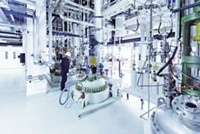Advertisement
Grab your lab coat. Let's get started
Welcome!
Welcome!
Create an account below to get 6 C&EN articles per month, receive newsletters and more - all free.
It seems this is your first time logging in online. Please enter the following information to continue.
As an ACS member you automatically get access to this site. All we need is few more details to create your reading experience.
Not you? Sign in with a different account.
Not you? Sign in with a different account.
ERROR 1
ERROR 1
ERROR 2
ERROR 2
ERROR 2
ERROR 2
ERROR 2
Password and Confirm password must match.
If you have an ACS member number, please enter it here so we can link this account to your membership. (optional)
ERROR 2
ACS values your privacy. By submitting your information, you are gaining access to C&EN and subscribing to our weekly newsletter. We use the information you provide to make your reading experience better, and we will never sell your data to third party members.
Pharmaceuticals
Custom Chemicals
by Rudy Baum,
January 28, 2008
| A version of this story appeared in
Volume 86, Issue 4
THIS WEEK'S PACKAGE of three cover stories on custom chemicals describes an industry that is undergoing enormous changes as traditional players establish a presence in Asia and the industry emerges from the economic doldrums of the early part of the decade.
Although not technically part of the package of cover stories, the lead Business Department article provides a fitting coda to them in its examination of Indian companies, many of them custom manufacturers themselves, entering the challenging drug discovery business.
The cover stories were written by C&EN Senior Correspondent Ann Thayer. Her report on Western firms building a presence in Asia is both fascinating and, from the perspective of the chemical enterprise in the U.S. and Europe, somewhat chilling.
"To compete now," Thayer writes, "U.S. and European custom chemicals companies that have long depended on advantages in technology, IP protection, and regulatory compliance are diversifying their operations to leverage lower cost production. Many have been searching for suppliers and partners in Asia. Some have jumped in with both feet, acquiring assets or building plants in China and R&D centers in India."
David Moody, vice president for commercial operations at Almac Sciences in Northern Ireland, couldn't have been more blunt. "We have come to the conclusion that building substantial new manufacturing assets in the West is not the way for us to go, and we question whether it's the way for anyone to go," Moody tells Thayer. "Our strategy very much has been to build relationships with others that already have relatively low-cost plants, wherever they may be."
Pfizer CentreSource has responded to price competition from Asian steroid producers by establishing partnerships with companies in Shanghai and Taiwan. Jeffrey W. Frazier, PCS vice president for fine chemicals, tells Thayer, "We decided to split our steroids supply chain, doing the bioconversion in Kalamazoo, Mich., and then moving intermediates over to partners who complete the chemical processing." Thayer notes that the strategy allows PCS to "keep its proprietary large-scale bioconversion capability for steroid intermediates in the U.S. and move the labor-intensive chemical steps overseas."
Other custom manufacturers like Lonza and SAFC have decided to build their own facilities in Asia. In any case, what is happening is that where custom chemicals are manufactured is becoming irrelevant. That's a big change that has happened in a very short period of time.
Regulators have not kept up with this shift in custom chemicals manufacturing, Thayer points out in the second of her cover stories. "The Food & Drug Administration knows pretty well what products are coming across U.S. borders, but it is much less certain about who's producing them or how well," Thayer writes. "Whether for safety or business reasons, trade groups that represent Western chemical companies see FDA's uncertainty as a problem."
FDA data show that foreign producers of active pharmaceutical ingredients are inspected much less frequently by the agency than U.S. facilities are, Thayer reports. Western producers see this discrepancy as unfair. Both the Synthetic Organic Chemical Manufacturers Association and the European Fine Chemicals Group have been calling for regulatory changes to create a level playing field, arguing that companies that don't comply with international good manufacturing practices enjoy unfair competitive advantages.
Associate Editor Lisa Jarvis recently spent time in India, attending CPhI India and visiting a number of Indian pharmaceutical companies. Drug discovery is a brutally challenging business, but Jarvis reports on several Indian companies' nascent efforts to jump into it. The first products of those efforts, in the form of a handful of new chemical entities, could reach the market as early as 2010, she reports.
These changes in custom chemicals manufacturing and drug discovery are remaking important elements of the chemical enterprise at an astonishing pace. It is a fascinating, and scary, time to be observing it.
Thanks for reading.
Views expressed on this page are those of the author and not necessarily those of ACS.




Join the conversation
Contact the reporter
Submit a Letter to the Editor for publication
Engage with us on Twitter